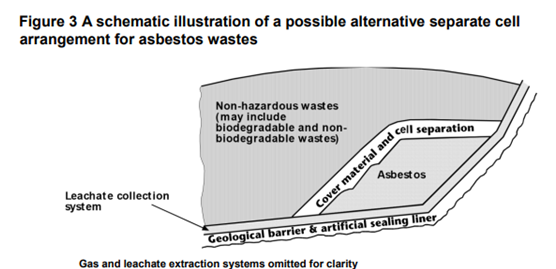Stabilised Non-Reactive Hazardous Waste: Difference between revisions
mNo edit summary |
m minor text change |
||
| Line 1: | Line 1: | ||
[[Category:Tonnage & Waste Types]] | [[Category:Tonnage & Waste Types]] | ||
A [[Non-Hazardous Landfill]] can receive | A [[Non-Hazardous Landfill]] can receive [[Stabilised Non-Reactive Hazardous Waste]] if certain criteria are met, including acceptance limits and the requirement that any cell which receives this material is separated from cells receiving Biodegradable Waste. This includes Gypsum waste and high Sulphate waste (such as [[Plasterboard]]) within acceptance limits to prevent the 'unacceptable emissions of hydrogen sulphide gas'. If the acceptance limits for 'high sulphate bearing wastes' are exceeded then the material must go to a [[Hazardous Landfill]]. | ||
The most recent UK guidance on the [[Landfill Directive]] and the [[Landfill]] of Stabilised Non-Reactive Hazardous Waste that sets out the requirements is LFD1 Understanding the Landfill Directive<ref>[https://www.gov.uk/government/publications/understanding-the-landfill-directive-lfd-1] LFD1 Understanding the Landfill Directive</ref> is published by the [[EA]] and referred to by the other regulatory bodies in the UK. | The most recent UK guidance on the [[Landfill Directive]] and the [[Landfill]] of Stabilised Non-Reactive Hazardous Waste that sets out the requirements is LFD1 Understanding the Landfill Directive<ref>[https://www.gov.uk/government/publications/understanding-the-landfill-directive-lfd-1] LFD1 Understanding the Landfill Directive</ref> is published by the [[EA]] and referred to by the other regulatory bodies in the UK. | ||
Revision as of 10:58, 8 December 2020
A Non-Hazardous Landfill can receive Stabilised Non-Reactive Hazardous Waste if certain criteria are met, including acceptance limits and the requirement that any cell which receives this material is separated from cells receiving Biodegradable Waste. This includes Gypsum waste and high Sulphate waste (such as Plasterboard) within acceptance limits to prevent the 'unacceptable emissions of hydrogen sulphide gas'. If the acceptance limits for 'high sulphate bearing wastes' are exceeded then the material must go to a Hazardous Landfill.
The most recent UK guidance on the Landfill Directive and the Landfill of Stabilised Non-Reactive Hazardous Waste that sets out the requirements is LFD1 Understanding the Landfill Directive[1] is published by the EA and referred to by the other regulatory bodies in the UK.
Two figures for possible separation of cells are included in the guidance and are repeated below:
 |
 |
Asbestos Waste can be deposited in a separate cell, but only if it is sufficiently self contained and designed not to be disturbed in the future, as shown in the following figure from the guidance:
 |
